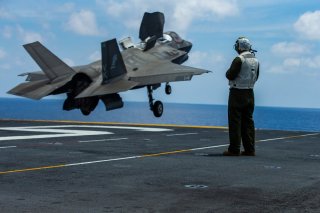The U.S. Marine’s Top Dog Has a New Plan To Fight a High-End War in the Pacific
Marine Corps. Commander Gen. David Berger has said that force dispersal will be crucial for a fight in the Pacific Region.
Marine Corps Commander Gen. David Berger outlined just what the U.S. Marine Corps needs to do in order to prepare for a high-end, peer-peer fight in the Pacific region.
Berger’s comments were delivered as part of the annual Modern Day Marine event, an annual conference for Marines, media and defense industry experts that showcases what is in store for the Corps in the future. This year’s edition was held virtually due to the ongoing global pandemic.
Since the end of World War II, and especially after the conclusion of the Korean conflict, American forces in the Pacific—most especially the Marine Corps—have been positioned with an eye to those two regions. From a historical standpoint, this posture makes sense but is no longer the best choice for preparing for a conflict with the strongest power in Asia, the People’s Republic of China.
Berger acknowledged the adjustment needed in the Marine Corps’ presence in Asia. “I know we are taking a look at the posture of U.S. forces in the Pacific,” he explained. “They [Marine forces] were well designed and well crafted, pointed from California to Japan like an arrow at the Korean Peninsula to make sure that if there was another problem on the Peninsula we’d be well-positioned to handle it,” but acknowledged that in the medium- to long-term, this force posturing won’t work in the future.
Dispersal: Hard to Find, Hard to Kill
In an era when Chinese ballistic missile forces are expanding, as is the Chinese Navy (currently the largest Navy in the World), the wisdom of densely concentrated American forces on bases in China’s backyard is increasingly in question. The Department of Defense China Power Report 2020 underscores just how vulnerable the United States currently is in the Pacific, explaining that Chinese bombers, rocket forces, and intermediate-range ballistic missiles can strike targets as far away as Guam in the Western Pacific.
The key to protecting America forces from Chinese strikes? Dispersal, Berger emphasized. “We have to spread out, we have to factor in Guam,” he stated. “We have to have a disbursed, distributed lay down in the Pacific that allows us to work with all the partners and allies and deter forces like the PLA from asserting themselves in a manner that tries to rewrite the global norms that have been well established in the past seventy years. So, our posture must change.”
This force dispersal strategy has been mulled over before. Some Marines have suggested widely-dispersed and decentralized groups of Marines could benefit from small, hard-to-detect, and automatically piloted resupply ships similar to narcosubmarines. These cheap transports could in theory reach far-flung groups of Marines and keep fed, watered, and armed.
The same goes for land-based systems as well. The Marine Corps is currently developing a remotely-operated, unmanned Joint Light Tactical Vehicle that would carry anti-ship missiles, lying in wait on remote specks of land to take out Chinese ships. These trucks-turned-ship-killers would be spread out far and wide and reduce the risk to Marine lives.
Postscript
The Marine Corps has already made huge strides in preparing for another Pacific fight. The Marine Corps recently began divesting all their tank battalions. Their Assault Amphibious Vehicle replacement is also being delivered to the Marine Corps. Equipment aside, the USMC is particularly well-suited to a more widely-dispersed force posture thanks to their leadership structure that discourages centralized decision making in favor of bottom-up initiative and aggression. What exactly tomorrow’s Marine Corps will look like remains to be seen, but make no mistake—the USMC is rapidly getting ready for a Pacific fight.
Caleb Larson is a defense writer for the National Interest. He holds a Master of Public Policy and covers U.S. and Russian security, European defense issues, and German politics and culture.
Image: Reuters

